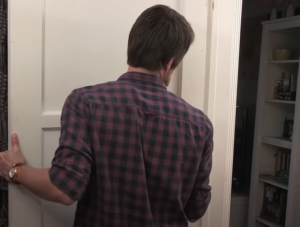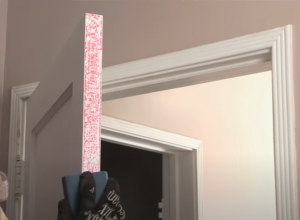A 'jammed' or 'sticking' door is where you have a door that doesn’t want to close or open easily. You'll usually have to give it some encouragement to open or close, by way of a push or pull. There may be a squeaking or scraping sound associated with the problem, and the door perhaps shudders or flexes when opened/closed.
There are three main reasons why a door will be sticking or jammed:
- There is a lot of humidity in the air, causing the door to swell and touch the door frame;
- The door hinges could be loose, causing the door to sag and touch the door frame. Loose hinges can be caused by a number of mechanisms such as heavy things being hung off the door, the door being pushed against when closed, and sometimes just due to normal use over time; and/or
- The house / building has settled over time causing the door-frame to change shape and press against the door. This is particularly common in older houses.
Diagnosis:
First you’ll need to identify where the door is sticking. On some doors it will be easy to tell where the problem is because there will be paint scratched off the door and/or door frame where they come into contact. If you’re not sure where the door is sticking; take a piece of coloured chalk and rub it along the edges of the door. Then close the door and see where the colour has transferred to the door-frame.

Secondly; check to see if the door’s hinges are tight. Do this by opening the door so that it's at a right angle to the door frame, hold the door firmly by both sides and push it against the door frame. Look and feel to see if the hinges are moving or flexing where they attach to the door or door-frame. If a hinge is loose; nine times out of ten it's going to be a top hinge, as the weight of the door 'pulls' on top hinges, whereas it 'pushes' on bottom hinges.

Fixing the problem:
If your hinges are loose, rectify this problem first. This alone may resolve the sticking door without need for further work. Your goal is to tighten the screws on the loose hinge so that it pulls back tightly against the door or door frame. Thereby pulling the whole door back into place so it can open and close without sticking.
If there is paint over the hinges (particularly in older houses) you may need to remove layers of paint to get to and adjust the screws on the hinges. Be sure to score around the hinge with a sharp knife so that you don’t accidentally remove paint off the door frame.
Sometimes the movement of the loose hinge over time will cause screws to strip out their screw holes and you’ll find that a screw is just spinning in its hole and not tightening. In this case you can either replace the screw with a longer or wider screw, or you can fill the stripped out hole with fine slivers of timber, matchsticks or toothpicks. Clip or cut off any timber/matchstick/toothpick that sits proud of the screw hole so that the hinge has a flat surface to press against. Once this is done; re-insert the original screw and screw it in. The screw will be nice and tight and will pull the hinge back into place.

If your hinges were loose and fixing the hinges alone solves the problem, that’s excellent! But if your hinges are tight and the door still sticks it’s likely to be a result of your door swelling or your doorframe changing shape due to your house settling. In this case the solution is sanding or planning your door to fit the door frame.
Having identified the area where the door is sticking; take sand paper, an electric sander or even a hand or electric planer and start sanding/planning off the sticking edge of the door. Be sure that you’re only taking off as much of the door as necessary by regularly stopping and checking if the door closes without sticking. If you need/want to re-paint the door and/or door frame remember that you’ll need to take enough off the door's edge to allow room for those coats of paint.

Whether or not to remove the door? This job is going to be easier if it can be completed without removing the door from the door frame. Leaving the door attached means you can open and close the door throughout the job to check if/when you've fixed the sticking point. So if your door repair is a small job, by all means leave the door in place.
However; if you need to do extensive sanding, planning and/or painting; and you don't want such a big mess in your house, it may be best to take the door off the frame in order to take the job outside. If you do have to remove the door you'll have to subsequently re-hang it. Hanging doors is a slightly more complicated process, but is by no means impossible. You'll need to chock the door in place by putting timber or cardboard under it to hold it at the correct height when you re-attach it. This sounds simple in theory, but it's a little fiddly in practice, be patient and if possible get someone to assist you and you'll be just fine.
I hope this blog helps gives you the knowledge and confidence to get after your sticking doors, if you‘d like me to assist you in any way please don’t hesitate to contact me.

